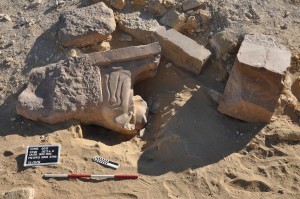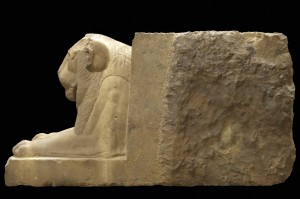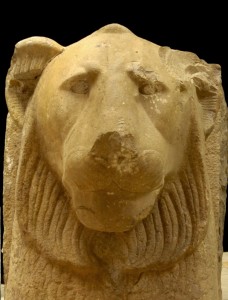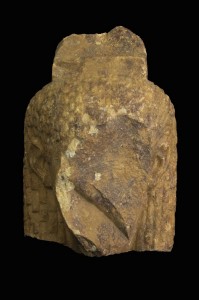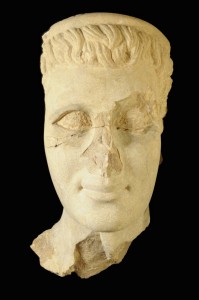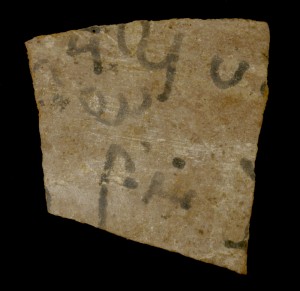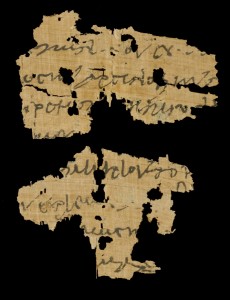Soknopaiou Nesos - Report 2012
Report of the Directors: archaeological season 2012
The Archaeological Mission of the Centro di Studi Papirologici of the University of Salento, Lecce, directed by Mario Capasso and Paola Davoli, carried out the Tenth Excavation Season at Dime es-Seba (El-Fayyum), the ancient Soknopaiou Nesos, from 26 October to 10 December 2012.
Also taking part in the Mission were Ashraf A. Mostafa (geologist, University of Asyut), Stefania Alfarano (assistant archaeologist), Clementina Caputo (ceramicist), Mauro Cremaschi (geoarchaeologist, University of Milano), Sylvie Marchand (senior ceramicist, IFAO), Giuseppe Alvar Minaya (supervisor), Moataz Abu el-Nil (assistant directors), Mohammed Ahmed (conservator), Anna Chiara Muscogiuri (registrar), Simone Occhi (surveyor), Roberta Petrilli (egyptologist, Vatican Museums), Elvira Pisanello (senior registrar, papyrologist), Borna Scognamiglio (egyptologist, Paris-Sorbonne), Stefania Trizza (assistant archaeologist). The Supreme Council of Antiquities was represented by the inspectors Ahmed Mawad and Ahmed Hassan.
The Mission would like to thank the Dr. Mohammed Ibrahim, Minister of the Egyptian Antiquities, the General Director of the Foreign Mission Mohammed Ismail, the Director of Middle Egypt Abd el Rahman el Aidi, the Director of the Inspectorate of Antiquities of the Fayyum Ahmed Abdel-Aal Mohammed for the support received in the course of works. It also expresses its gratitude to both. cav. Luca Trombi, who, as every year, assured the Mission generous and vital financial support, and the supporters of the “Cultural Association Soknopaiou Nesos Project”. In particular we thank the Centro Internazionale di Studi Borgiani of Velletri, chaired by dr. Rigel Langella, for the scholarship provision for young scholars participating in the Mission.
Thanks also to the Italian Foreign Ministry for the financial contribution 2012 and Mrs. Cecile Safwat, archaeological section of the Italian Institute of Culture in Cairo, who was responsible for relations with the Supreme Council of Antiquities.
The excavation 2012
The excavation took place in the great temple enclosure, in the centre of the temenos. The west side of the temple dedicated to the god Soknopaios (ST 20) (Fig. 1) has been completely excavated. The investigation of this side started in 2010.
The excavated area is long 18.60 m from north to south and wide 6.50 m from east to west. A lot of building materials derived from the spoliation of the walls of the temple ST 20, as blocks of yellow limestone, grey limestone pavement slabs, parts of lintels and considerable accumulation of gypsum mortar for the blocks of the temple was recovered. The accumulation of the debris of gypsum mortar was present on the whole area of the building and has been originated from the activity of demolition of the temple probably occurred since the Byzantine period. Its texture on the excavated area was very compacted and has protected the original underlying stratigraphy from clandestine excavations.
Among the building materials found in this deposit there were two groups of large blocks belonging to the original gutters of the temple. They consist of two large gutters in fossiliferous grey limestone, two imposing lions that formed the decoration of the gutters and two supports (Fig. 2). The lions, different from each other both in size and in style, are perfectly preserved and carved with great skill and care up to their shoulders. The backside of the blocks have been left rough as they were intended to be inserted in the perimeter wall of the temple. The lion found in the southern part of the area (ST12/802/3743) measures 156 cm in length, 65 cm in width and 51 cm in height. One found further north instead measure 166 cm in length, 88 cm in width and 50 cm in height (ST12/803/3744). These gutters decorated with large lions are similar to those of Dendera and other Upper Egyptian temples. This find proves that the temple dedicated to the local god Soknopaios was built with great accuracy and monumentality. So far, these are the first decorated gutters found in the Fayyum sites. A similar decoration was present in the temple of Dionysias / Qasr Qarun, but it is only partially preserved.
Several fragments of statues, including two heads representing a male and a female were also found. Both are carved with excellent manufacturing in local fossiliferous limestone, as well as an incense burner (thymiaterion) (Fig. 3).
A floor made with slabs of grey fossiliferous limestone is perfectly preserved on the whole investigated sector. Its extension to the north and west remains unknown due to the limits of the excavation (Fig. 4). This pavement is a renovation of the original floor, built during the restoration of the external bottom of the west wall in ST 20. In fact, it abuts a coating of grey limestone slabs applied with large quantities of white mortar to the lower part of the outer wall heavily eroded by the elements. The new casing is completely different and less accurate than the one built along the east perimeter wall of the same building recovered in 2009-10.
We cut two trenches in the floor (Trench 8 and Trench 9) in order to ascertain the time of the construction of the temple and its restoration. The trenches are located at both ends of the floor. Trench 8 (2.20 x 3 m) was excavated to a depth of 1.90 m from the floor, but the end of anthropic stratigraphy was not reached. The excavation will continue in 2013. Two walls, perpendicular to each other and to the temple, were discovered. They are built with rough stones bounded with mud mortar. They probably belonged to two different buildings demolished for the construction of the temple ST 20. The visible sides are probably the outer ones. The study of the findings will provide a dating of the various phases recognized. In addition to the usual fragments of common pottery and amphorae, two Greek ostraka of the Roman period and 10 Demotic ostraka were found.
Trench 9 (1.65 x 1.95 m) has reached a depth of 1.95 m. The stratigraphy found differs in part from that of the Trench 8. In fact, a thick layer of artificial fill of the foundation trench of temple ST 20, consisting of mixed materials of construction and demolition of buildings, sand and organic deposits, was found only in the south trench. Its surface, flat and hard, has been certainly a walking surface outside the temple for a period of time. At the bottom of the trench the top of a wall in rough stones, partially demolished, has been brought to light.
The stratigraphy deserves further and more thoroughly investigation in the future.
A total of 17 ostraka (11 Demotic, 2 Greek, 2 figured, 2 Greek tituli picti), four scraps of papyri (3 Greeks, one hieroglyphic) and two inscriptions (one Greek, one hieratic) were found (Fig. 6).
From November 4 to 8 a pottery survey was carried out by Sylvie Marchand in a wide area to the west of Dime, together with C. Caputo and S. Occhi. Potsherds have been systematically collected in particular in the area of the so-called “Watch Towers”, on the shores of a paleo-lake and around the triangular structure whose function and dating are not yet known. Eleven new sectors (Sectors 36-56) are to be added to the 35 areas examined in 2010. The collected pottery has been dated between the Neolithic Age and the New Kingdom. It confirmed the presence of a settlement of the New Kingdom located west of Dime, of which only few scattered graves, ceramics and few items are preserved. The dwellings have disappeared due to the harsh erosion that has resulted in a significant decrease in the walking surface elevation on which the artefacts now lies (Fig. 5).
In the course of the survey the destruction by means of an excavator of the greater hill of the series “Watch Towers” has been documented. It is a natural hill on which a stone squared wall was built. The destruction is probably a consequence of the news published from different web sites, completely false and irresponsible, in which the identification of “Pyramids” in this area are claimed.
M. Cremaschi, Ashraf Mostafa and S. Occhi continued the geomorphological survey already started in 2007. The survey was carried on from 9 to 16 November in order to better define the geomorphological nature of the plateaux on which Dime stands and better understand the change of the landscape during the various prehistoric and historic periods. The surveyed area is comprised between the edge of the Jebel Qatrani to the north, the edges of the Moeris Bay to the east and up to a deep wady to the west. To the south the sequence of coastal shores of the current margin of Birket Qarun was investigated.
The 2012 survey has confirmed the geomorphological context, which was already observed during 2007, and 2008 seasons. Lacustrine carbonates littoral and aeolian sand have been recorded and surveyed in detail (yardangs). Their sedimentological study will allow a reconstruction of the oscillations of the Fayyum lake from the beginning of the Holocene until the Roman period and the morphological evolution of the territory under study. In particular the analysis of yardangs allowed identifying the alternation of depositional and erosive phenomena. These yardangs are caused by phenomena of climate changes, and perhaps are closely related to human activity. They have significantly reshaped the ancient landscape. Stratigraphic columns at various points considered critical have been described in detail.
Fig. 1: The temple of Soknopaios and the excavated areas (2012).
Fig. 2: The gutters decorated with sculptures of lions.
Fig. 3: The heads of two statues of fine workmanship.
Fig. 4: The floor of the Roman period along the west side of the temple of Soknopaios.
Fig. 5: Ceramic survey: sites dating from the New Kingdom.
Fig. 6: A Demotic ostrakon (ST12/826/3846) and a Greek papyrus (ST12/807/3870).













